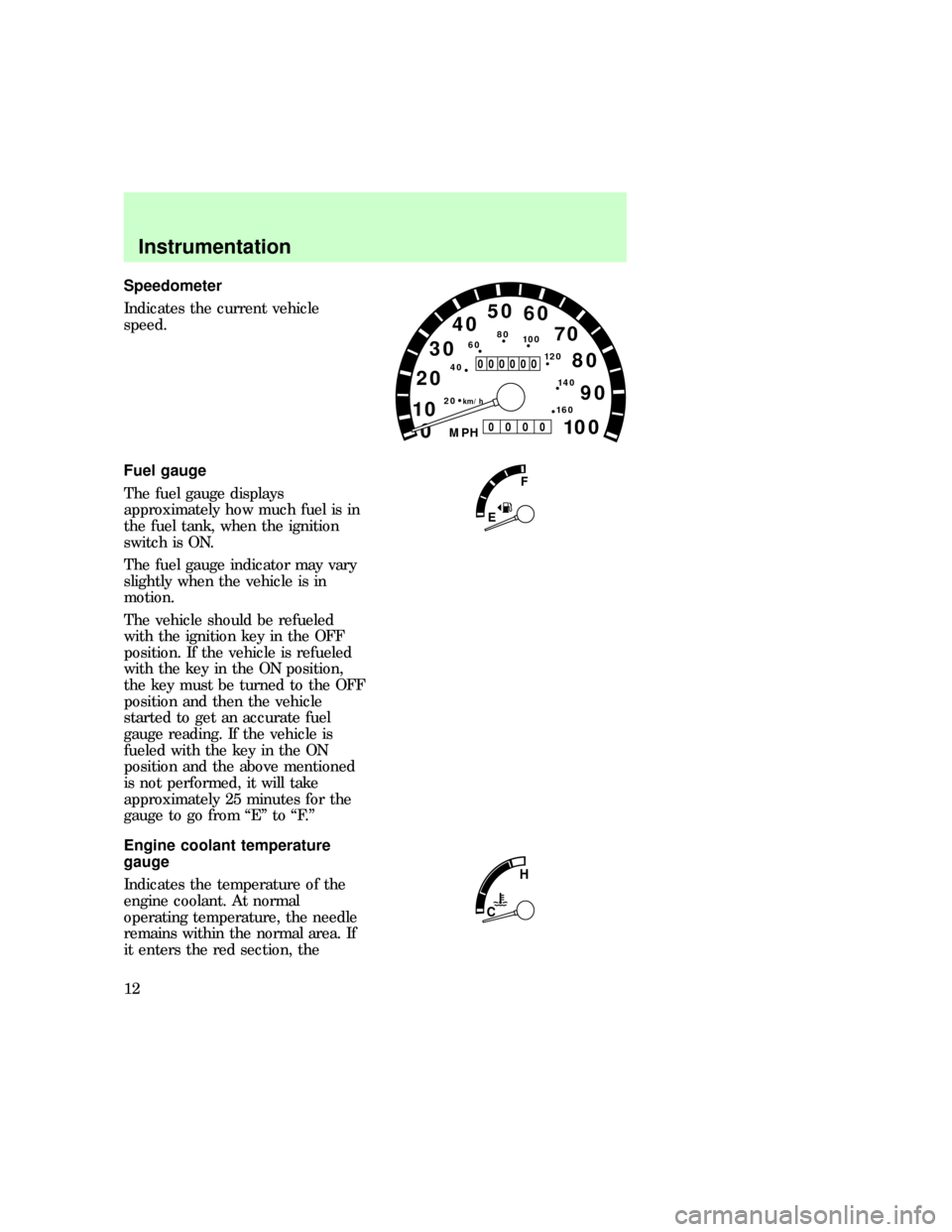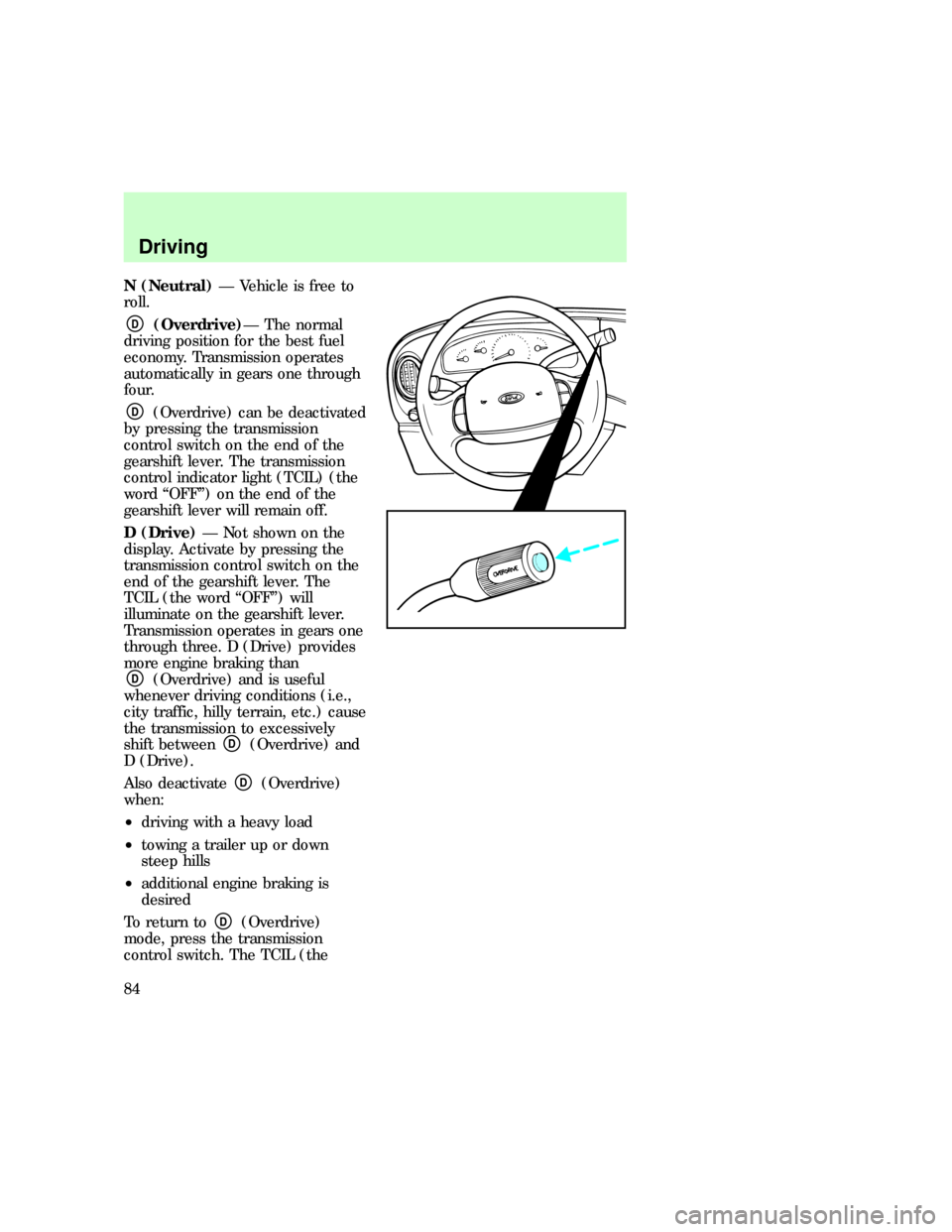Page 3 of 192

additional information, please
contact the Light Truck Body
Builders Advisory Service
1±800±635±5560.
Use of your Ford light truck as an
ambulance, without the Ford
Ambulance Preparation Package
voids the Ford New Vehicle
Limited Warranty and may void the
Emissions Warranties. In addition,
ambulance usage without the
preparation package could cause
high underbody temperatures,
overpressurized fuel and a risk of
spraying fuel which could lead to
fires.
If your vehicle is equipped with
the Ford ambulance preparation
package, it will be indicated on the
Safety Certification Compliance
label. The label is located on the
driver's side door pillar or on the
rear edge of the driver's door. You
can determine whether the
ambulance manufacturer followed
Ford's recommendations by
directly contacting that
manufacturer. Ford Ambulance
preparation package is only
available on certain 7.3L Diesel
Econoline vehicles.
Diesel-powered vehicles
Read the 7.3L Diesel Engine
Owner's Guide Supplement for
information regarding correct
operation and maintenance of your
eco_diesel_notice
Introduction
3
Page 6 of 192
OVERDRIVE
ON
OFFRES
SET
ACCEL
COAST
Engine coolant
temperature gauge
(pg. 12)
Fuel Gauge
(pg. 12)Speedometer
(pg. 12)Engine oil
pressure gauge
(pg. 13)
Battery
voltage
gauge
(pg. 13)
Warning
lights
(pg. 8)
Speed controls
(pg. 28)
Headlamp switch
and dimmer
(pg. 15)Transmission
control switch
(pg. 24)
Wiper/washer
control
(pg. 27)
Instrumentation
6
Page 12 of 192

Speedometer
Indicates the current vehicle
speed.
Fuel gauge
The fuel gauge displays
approximately how much fuel is in
the fuel tank, when the ignition
switch is ON.
The fuel gauge indicator may vary
slightly when the vehicle is in
motion.
The vehicle should be refueled
with the ignition key in the OFF
position. If the vehicle is refueled
with the key in the ON position,
the key must be turned to the OFF
position and then the vehicle
started to get an accurate fuel
gauge reading. If the vehicle is
fueled with the key in the ON
position and the above mentioned
is not performed, it will take
approximately 25 minutes for the
gauge to go from ªEº to ªF.º
Engine coolant temperature
gauge
Indicates the temperature of the
engine coolant. At normal
operating temperature, the needle
remains within the normal area. If
it enters the red section, the
0 1020304050
60
70
80
90
10 0
20 km/h
406080
10 0
12 0
14 0
16 0
MPH
000000
0000
F
E
H
C
eco_fuel_gauage
com_coolant_temperature.03
Instrumentation
12
Page 24 of 192
the vehiclein theStarting
chapter.
Gearshift
For information on the gearshift,
refer toAutomatic Transmission
Operationsection of theDriving
chapter.
Using overdrive
D(overdrive) is the normal drive
position for the best fuel economy.
The overdrive function allows
automatic upshift and downshift
operation in all gears.
P RN 21D
P RN 21D
eco_gearshift eco_overdrive_operation
eco_overdrive-off
Controls and features
24
Page 74 of 192
If you smell exhaust fumes
inside your vehicle, have
your dealer inspect your vehicle
immediately. Do not drive if you
smell exhaust fumes.
Preparing to start the vehicle
Engine starting is controlled by the
spark ignition system. This system
meets all Canadian
Interference-Causing Equipment
standard requirements regulating
the impulse electrical field strength
of radio noise.
When starting a fuel-injected
engine, avoid pressing the
accelerator before or during
starting. Only use the accelerator
when you have difficulty starting
the engine. For more information
on starting the vehicle, refer to
Starting the vehiclein this
chapter.
Before starting the vehicle:
1. Make sure all vehicle occupants
have buckled their safety belts. For
more information on safety belts
and their proper usage, refer to
eco_preparing_start
Starting
74
Page 84 of 192

N (Neutral)Ð Vehicle is free to
roll.
D(Overdrive)Ð The normal
driving position for the best fuel
economy. Transmission operates
automatically in gears one through
four.
D(Overdrive) can be deactivated
by pressing the transmission
control switch on the end of the
gearshift lever. The transmission
control indicator light (TCIL) (the
word ªOFFº) on the end of the
gearshift lever will remain off.
D (Drive)Ð Not shown on the
display. Activate by pressing the
transmission control switch on the
end of the gearshift lever. The
TCIL (the word ªOFFº) will
illuminate on the gearshift lever.
Transmission operates in gears one
through three. D (Drive) provides
more engine braking than
D(Overdrive) and is useful
whenever driving conditions (i.e.,
city traffic, hilly terrain, etc.) cause
the transmission to excessively
shift between
D(Overdrive) and
D (Drive).
Also deactivate
D(Overdrive)
when:
²driving with a heavy load
²towing a trailer up or down
steep hills
²additional engine braking is
desired
To return to
D(Overdrive)
mode, press the transmission
control switch. The TCIL (the
Driving
84
Page 97 of 192

hilly country or on hot days.
Speed control may shut off if you
are towing on very long, steep
grades.
When towing a trailer
If towing a trailer and your vehicle
is not equipped with the Ford
trailer tow package, an auxiliary
transmission fluid cooler is
recommended.
²Use D (Drive) rather than
D(Overdrive) while towing up
or down steep hills. This will
eliminate excessive downshifting
and upshifting for optimum fuel
economy and transmission
cooling.
²Anticipate stops and brake
gradually.
²Allow more room for stopping
with a trailer attached.
²Practice turning, stopping and
backing in an area before
starting on a trip to get the feel
of the vehicle/trailer
combination.
²When turning, drive slightly
beyond the normal turning point
so the trailer wheels will clear
curbs and other obstacles.
²When stopped in traffic for long
periods of time in hot weather,
place the gearshift in P (Park)
to increase idle speed. This aids
engine cooling and air
conditioner efficiency.
²Vehicles with trailers should not
be parked on a grade. If you
eco_when_towing
Driving
97
Page 98 of 192
must park on a grade, place
wheel chocks under the trailer's
wheels.
²After you have travelled about
80 km (50 miles), thoroughly
check your hitch, electrical
connections and trailer wheel
lug nuts.
Launching or retrieving a boat
When backing down a ramp during
boat launching or retrieval,
²Do not allow the static water
level to rise above the bottom
edge of the rear bumper and
²Do not allow waves to break
higher than 15 cm (six inches)
above the bottom edge of the
rear bumper.
Exceeding these limits may allow
water to enter critical vehicle
components, adversely affecting
driveability, emissions and
reliability.
Servicing when towing
If you tow a trailer for long
distances, your vehicle will require
more frequent service intervals.
Follow the severe duty
maintenance schedule outlined in
the ªService Guide.º
com_launch-retrieving_boat.01
eco_service_when_towing
com_fuel_consumption.01
Driving
98